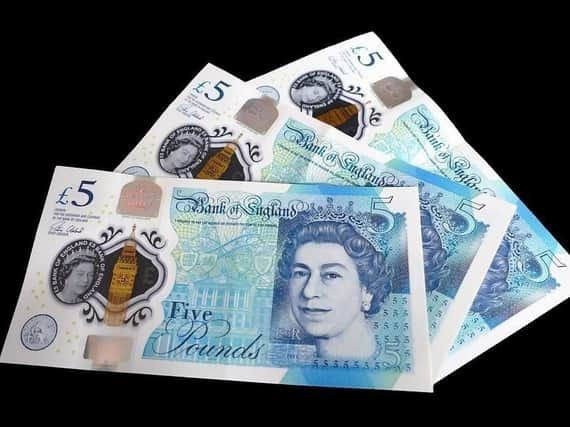Police urging people to 'know your notes'


Bank notes issued by the Bank of England carry a number of distinctive markings on both the polymer and paper notes, which assist in the identification of a genuine note.
These markings include ‘Bank of England’ printed in raised print, microlettering of the denomination below the Queen’s portrait
Advertisement
Hide AdAdvertisement
Hide AdThe new £5 and £10 polymer notes introduced over the past two years, carry a number of security features.
Both notes have a see-through window with a clearly defined portrait of the Queen and foil patches which show the written denomination of the note. A 3-D image of the coronation crown is also featured.
All genuine bank notes will also be high-quality print, with sharp colours and free from blurred edges or smudges and will react to ultraviolet light.
The £5 note, which features Sir Winston Churchill, has a finely detailed metallic image of Big Ben, which is gold on the front of the note and silver on the back. It also has a foil patch which carries an image of the Marlborough maze from Blenheim Palace – Sir Winston’s birthplace.
Advertisement
Hide AdAdvertisement
Hide AdThe £10 note features Jane Austen and carries a metallic image of Winchester Cathedral, where she is buried. As with the £5, the image is gold on the front of the note and silver on the reverse. The £10 note also carries an image of a quill, which changes from purple to orange when the note is tilted and a copper book-shaped foil patch, which contains the letters "JA".
The £20 and £50 note are currently still printed on special paper. Both carry a watermark portrait of the Queen, which is visible when held up to the light and a metallic thread, which weaves through the paper.
The £20 note also features a number of foil patches which contain holographic images of the economist Adam Smith, the number 20 and the £ symbol.
The £50 note has a motion thread which runs through the note, featuring images of the £ symbol and the number 50. These images move up and down and side to side, when tilted.
Advertisement
Hide AdAdvertisement
Hide AdDetective Inspector Jon Hodgeon, head of North Yorkshire Police’s Economic Crime Unit, said: “Fortunately counterfeit notes are quite rare, but sadly for those in receipt of them, they are worthless. Banks cannot reimburse individuals or businesses who fall victim to this type of fraud.
“Counterfeiting is not a victimless crime. Operations can directly fund organised crime and damages the UK economy by creating losses for individuals and businesses, which ultimately effects the costs of goods that you and I buy. We all end up paying for the cost of this type of crime.
“If you suspect that you have received a counterfeit note, please contact police on 101 or take it along to your local police station. We can take all the relevant details from you and pass the information over to the National Crime Agency, who will work with the Bank of England to examine the note.
“If you have any information about someone making, selling or using counterfeit notes, again please contact the police on 101 and report your suspicions. You can also contact Crimestoppers anonymously on 0800 555 111.”